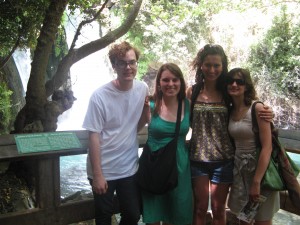
Four Williams students at Banias Falls, a site only a few kilometers north of the temple at Omrit. From left to right, Sam O’Donnell ’15, Emily Loveridge ’14, Lydia Heinrichs ’15, and Elvira Miceli ’13.
As I readjust to life on Kibbutz Kfar Szold, I am struck by just how comfortable I continue to feel on the dig. In large part I owe this feeling to the wonderful people who have made this trip possible for me, not once but twice—everyone from Greta, in charge of our lives on the kibbutz, to the wonderful and endlessly entertaining Professor Rubin, to my square members, new and old, to my lovely suitemates in Room 29. Yet, having recently wrapped up another intense semester at Williams, I can also appreciate just how unique a learning experience Omrit has provided me. Too often I finish a class at Williams oversaturated with information that I forget a few weeks later. After only a few days at Omrit, however, I feel myself hit my stride once more, identifying pottery sherds, taking and recording elevations, and trimming balks, as if I had never left. The qualities that I love the most about the Omrit experience, however, are those that every college class seeks and, perhaps by nature, cannot obtain: both depth and breadth. I am already developing a close familiarity with the 5×5 meter square in which I have worked for the past three days. This, in turn, contributes to my understanding of Omrit as a whole, and, therefore, of provincial life in the Roman Empire during the Early Roman and Byzantine periods.
I have found my work as an assistant square supervisor particularly helpful in piecing together a broad understanding of my square from a few individual artifacts and seemingly meaningless fragments. Last year, one of my least favorite jobs on the dig was to “do the book”—measure artifacts, keep track of elevations, draw top plans, and (formerly the task I most dreaded) write daily narratives, or records of our progress and thought processes throughout each day. Still basking in wonder at the tactile aspects of archaeology—the “finding cool old stuff” part—I struggled to resign myself to actually writing down everything our square uncovered, instead focusing on the stuff I myself had dug up. Inevitably, as the joy of finding new things wore off, I found myself disappointed that we had not made any earth-shattering discoveries. This year, however, taking charge of the book as a square supervisor, I have realized that the task of the book is not simply recording, but also an invaluable opportunity to take a step back from individual artifacts, to draw together seemingly disparate observations, discarding some ideas, reevaluating old ones, and uncovering new connections, as well as new questions. Accompanying this understanding of the “bigger picture” of the site, of course, is a newfound acknowledgement that individual artifacts, architectural structures, and even whole squares don’t always make sense together, or knit themselves into one cohesive archaeological picture. This is quite a humbling revelation.
In fact, despite my feeling that I have come a long way since last season, I must remind myself that I have served only three days as an assistant square supervisor. Learning is a lifelong process, and the past week as a returner at Omrit have only brought home to me how much more I have yet to understand about everything—square F19, archaeology as a discipline, Omrit, and the Golan, never mind the Roman Empire, the history of the Syro-Palestine region, and, in particular, my own interest, the Late Roman and early medieval periods. Let the journey begin!
